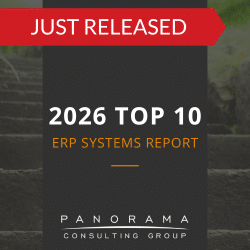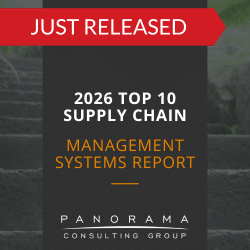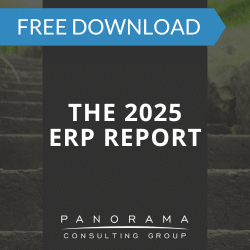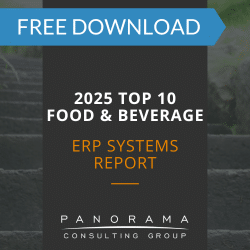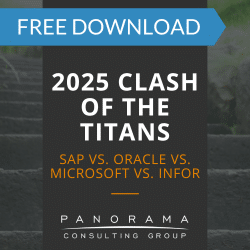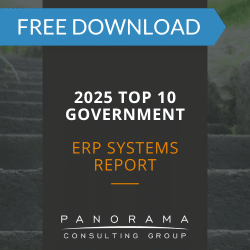Key Takeaways:
- Data silos create strategic risk by hiding inefficiencies, delaying decisions, and fragmenting enterprise visibility.
- ERP success depends on data integration—without unified systems and governance, transformation efforts stall.
- Master data management is critical to eliminating duplicate records, inconsistent metrics, and conflicting reports.
- Executives must lead data governance to align people, processes, and technology for lasting digital transformation.
One of the biggest risks in digital transformation is information that remains hidden. In fact, operational blind spots, disconnected systems, and decisions made based on fragmented data can be precursors to project failure.
As enterprise software consultants, we see how these risks evolve across the ERP lifecycle, from the earliest phases of software selection to the critical, post-go-live period where business value is either realized or lost.
Despite significant investments in ERP systems, data fragmentation in organizations often persists or even worsens. This compromises visibility, delays decisions, and fuels ERP failures.
Today, we’ll explore the real business risk of data silos, why master data management challenges continue to stall transformation, and how executives can build a more integrated future by treating data as a strategic asset.
Contemplating litigation?
We have multiple software expert witnesses available for provision of reports, depositions, and testimonies.
Why Data Silos Are a Leadership Problem
Too often, organizations approach data issues as purely technical hurdles. But data silos emerge from structural decisions: how business units operate, how systems are selected, and how processes are enforced.
Consider a global manufacturer with separate systems for finance, procurement, and inventory across regions. When forecasts vary wildly between divisions, the issue may not be the formula in the spreadsheet. It might be underlying data issues, like conflicting naming conventions, outdated product hierarchies and inconsistent customer records.
This is not a system problem. It is a visibility problem.
Executives depend on data to evaluate margin pressure, working capital efficiency, and supplier performance. Yet when systems operate in silos, every dashboard is a partial truth. Leaders make high-stakes decisions based on narrow views, often unaware that the broader story is missing.
This is where the danger lies: you do not know what you do not know.
Strategic Implications for Supply Chain Management
For organizations that rely on a supply chain management system, data silos can be catastrophic. Inaccurate demand signals, outdated supplier data, or fragmented logistics information erode the very agility ERP systems are meant to provide.
One global food manufacturer experienced this firsthand. The company’s regional divisions operated on aging systems that couldn’t communicate with each other. Forecasting, inventory management, and logistics were handled through a patchwork of spreadsheets and legacy tools.
The result was a lack of visibility across operations—some regions faced raw material shortages while others overproduced, driving up costs and complicating compliance tracking.
With Panorama’s guidance, the organization selected and implemented a modern ERP solution tailored to its complex production environment. The new system unified finance, manufacturing, and distribution processes, providing real-time visibility into supply chain performance and material requirements.
Strategic Implications for AI Technology
As organizations explore AI-enabled ERP capabilities, data maturity becomes the critical success factor. Without high-quality, harmonized data, predictive algorithms reinforce bad assumptions instead of improving insight.
Executives considering AI in ERP systems should first ensure their data architecture and governance are mature enough to support accurate, reliable predictions.
Causes of Data Fragmentation in ERP Environments
Organizations invest millions in popular ERP systems to unify operations. However, without strong integration and governance practices, data fragmentation continues.
Here are four common patterns we see during ERP selection and implementation:
1. Incomplete Integration Scope
Many projects underestimate how many systems feed into or depend on ERP data. Interdependent systems often include CRM tools, legacy pricing engines, and external warehouse systems. When integration is scoped narrowly, critical data remains stranded.
2. Master Data Inconsistencies Across Modules
ERP modules for finance, supply chain, and manufacturing often share overlapping data sets. Without centralized governance, master data management challenges emerge. Examples include duplicate vendors, inconsistent SKUs, and misaligned units of measure.
3. Lack of Data Ownership
When no business unit “owns” the data quality, silos flourish. This is especially risky during post-go-live phases, when operational issues are blamed on the ERP software but are often rooted in poor data practices.
4. Disparate Reporting Tools
When users export data into Excel to reconcile across systems, it is a signal that the core system is fragmented by design or neglected by governance. Reporting becomes reactive rather than strategic.
Real World Example:
A multinational manufacturer in the healthcare sector struggled with data fragmentation and inconsistent forecasting across its regional operations. Each business unit maintained separate accounting systems and independently managed demand planning, leading to duplicated records and misaligned data across the enterprise.
The lack of data integration and unified reporting slowed decision-making and limited visibility into global performance.
With Panorama’s guidance, the organization selected an enterprise-wide ERP platform emphasizing analytics functionality and scalability. The selection process entailed navigating multiple cultures and standardizing disparate processes. This enabled the organization to break down data silos and ensure their ERP was more than a transactional tool.
Executive Best Practices to Break Data Silos
1. Treat Master Data as Infrastructure
Master data is as critical as your chart of accounts or your manufacturing process. Treat it like enterprise infrastructure with defined ownership, audit processes, and lifecycle policies.
2. Build Integration into Your ERP Selection Criteria
When evaluating your ERP software list or a list of SCM vendors,you should prioritize systems that enable clean integrations, especially with AI capabilities you may implement in the future.
A credible ERP consultant will simulate integration complexity and evaluate candidates accordingly. Pressure-testing integration early can prevent multi-million dollar surprises down the road.
3. Align Data Strategy with Organizational Change
Data governance is not just a technical effort—it is a change management initiative. Adoption suffers when users resist new data processes or rely on old habits.
Successful transformation aligns people, process, and data. Change leaders should:
- Embed data stewards in business units.
- Include data literacy in user adoption programs.
- Reinforce the business value of accurate, shared data.
4. Design Post-Go-Live Vendor Governance Around Data
Post-go-live support often focuses on uptime and ticket resolution. Instead, vendors should be evaluated on their support for data-driven business outcomes:
- Reporting accuracy
- Planning cycle efficiency
- Order fulfillment rates
Learn More About the Risks of Data Silos
Data silos are rarely visible in project kickoff decks. But they show up later in missed forecasts, delayed close cycles, and lost customer trust.
Whether your ERP initiative is in planning, execution, or recovery, data governance must be a strategic focus. As an independent enterprise software consulting firm, we help organizations ensure data maturity, validate vendor claims, and design architectures that support unified operations. Contact us below to learn more.






